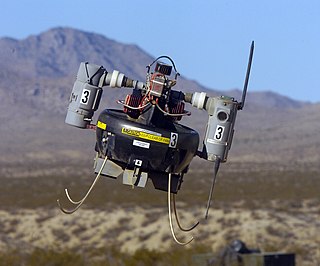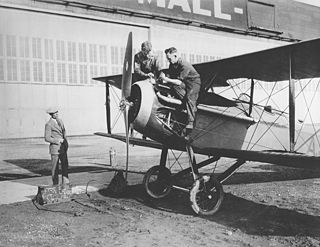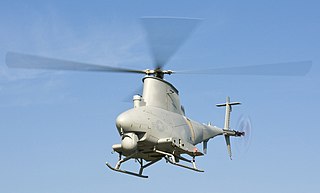Related Research Articles

The AAI RQ-7 Shadow is an American unmanned aerial vehicle (UAV) used by the United States Army, Australian Army, Swedish Army, Turkish Air Force and Italian Army for reconnaissance, surveillance, target acquisition and battle damage assessment. Launched from a trailer-mounted pneumatic catapult, it is recovered with the aid of arresting gear similar to jets on an aircraft carrier. Its gimbal-mounted, digitally stabilized, liquid nitrogen-cooled electro-optical/infrared (EO/IR) camera relays video in real time via a C-band line-of-sight data link to the ground control station (GCS).

A reconnaissance aircraft is a military aircraft designed or adapted to perform aerial reconnaissance with roles including collection of imagery intelligence, signals intelligence, as well as measurement and signature intelligence. Modern technology has also enabled some aircraft and UAVs to carry out real-time surveillance in addition to general intelligence gathering.

A micro air vehicle (MAV), or micro aerial vehicle, is a class of miniature UAVs that has a size restriction and may be autonomous. Modern craft can be as small as 5 centimeters. Development is driven by commercial, research, government, and military purposes; with insect-sized aircraft reportedly expected in the future. The small craft allows remote observation of hazardous environments inaccessible to ground vehicles. MAVs have been built for hobby purposes, such as aerial robotics contests and aerial photography.

Vought was the name of several related American aerospace firms. These have included, in the past, Lewis and Vought Corporation, Chance Vought, Vought-Sikorsky, LTV Aerospace, Vought Aircraft Companies, and Vought Aircraft Industries.

The Bell Helicopter Eagle Eye, Model 918, was an American tiltrotor unmanned aerial vehicle that was offered as one of the competitors in the United States Navy's VT-UAV program.

Israel Aerospace Industries or IAI (תע"א) is Israel's major aerospace and aviation manufacturer, producing aerial and astronautic systems for both military and civilian usage. It has 15,000 employees as of 2018. IAI is completely state-owned by the government of Israel.

Clackamas High School (CHS) is a public high school located in Clackamas, Oregon, United States. The school itself was built in 2002, replacing an older, smaller building built in 1957 which is now Alder Creek Middle School. Starting in the 2010–2011 school year, the campus included the former building of Sunrise Middle School. During the 2021-2022 school year, the East Campus building turned into Rock Creek Middle School.

The Northrop Grumman MQ-8 Fire Scout is an unmanned autonomous helicopter developed by Northrop Grumman for use by the United States Armed Forces. The Fire Scout is designed to provide reconnaissance, situational awareness, aerial fire support and precision targeting support for ground, air and sea forces. The initial RQ-8A version was based on the Schweizer 330, while the enhanced MQ-8B was derived from the Schweizer 333. The larger MQ-8C Fire Scout variant is based on the Bell 407.

Hellenic Aerospace Industry (HAI) is the leading aerospace company of Greece. The company headquarters is located in Tanagra, 65 kilometers north-west of Athens, with the industrial complex covering an area of 200,000 sq.m.

The John D. Odegard School of Aerospace Sciences is a multidisciplinary college within the University of North Dakota (UND) in Grand Forks, North Dakota. The school was formed in 1968. The majority of the school's fleet of over 120 aircraft is based at nearby Grand Forks International Airport and is the largest fleet of civilian flight training aircraft in North America. UND Aerospace also operates a flight training center in Phoenix, Arizona. Today, the school has many aerospace-related programs including commercial aviation, Unmanned aircraft systems operations, air traffic control, airport management, Space Studies, Computer Science, Atmospheric Sciences, and Earth System Science & Policy. Currently, the school has over 500 faculty and 2,000 students making it the second largest of UND's degree-granting colleges. The present dean of the school is Robert Kraus.
A scout plane is type of surveillance aircraft, usually of single-engined, two or three seats, shipborne type, and used for the purpose of discovering an enemy position and directing artillery. Therefore, a scout plane is essentially a small naval aircraft, as distinguished from a tactical ground observation aircraft, a strategic reconnaissance "spyplane", or a large patrol flying boat.

Wings is an hour-long televised aviation history documentary program which aired on the Discovery Channel family of networks. It was produced by Phil Osborn.

The TAI Anka is a family of unmanned aerial vehicles developed by Turkish Aerospace Industries primarily for the Turkish Air Force. Envisioned in the early 2000s for aerial surveillance and reconnaissance missions, Anka has evolved into a modular platform with synthetic aperture radar, precise weapons and satellite communication.

The aerospace industry of the United Kingdom is the sixth-largest national aerospace industry in the world and the third largest in Europe, with a global market share of 17% in 2019. In 2013, the industry employed 84,000 people.

The IAI Scout is a reconnaissance unmanned air vehicle developed in Israel in the 1970s by Israel Aircraft Industries as a competitor to the Tadiran Mastiff. The project was led by Charley Attali, David Harari, and Michael Shefer who were all awarded the 1981 Israel Defense Prize. During the 1970s, the Israeli military was becoming increasingly interested in battlefield UAVs, and in response IAI management finally decided that they were interested in the concept as well. The Scout had a similar configuration as the Mastiff, with a pusher propeller and a twin-boom tail.

The Boeing AH-6 is a series of light helicopter gunships based on the MH-6 Little Bird and MD 500 family. Developed by Boeing Rotorcraft Systems, these include the Unmanned Little Bird (ULB) demonstrator, the A/MH-6X Mission Enhanced Little Bird (MELB), and the proposed AH-6I and AH-6S.

Oregon Iron Works, Inc. (OIW) is an American manufacturer of complex structural components and systems and specialized vehicles, located in the Clackamas area in the southeastern suburbs of Portland, Oregon. Established in 1944, it is involved in a number of different industries, supplying products ranging from high-speed boats for military use to purpose-built girders for roadway bridges. It has production facilities in Clackamas and in Vancouver, Washington, and currently employs about 400 people. In May 2014, the company announced that it was merging with Portland-based Vigor Industrial.
FCS/BCT unmanned aerial vehicles was a collection of unmanned aerial vehicles developed under the jurisdiction of the Future Combat Systems (FCS) program until it was dissolved and succeeded by the BCT Modernization program.
Unmanned aircraft system simulation focuses on training pilots to control an unmanned aircraft or its payload from a control station. Flight simulation involves a device that artificially re-creates aircraft flight and the environment in which it flies for pilot training, design, or other purposes. It includes replicating the equations that govern how aircraft fly, how they react to applications of flight controls, the effects of other aircraft systems, and how the aircraft reacts to external factors such as air density, turbulence, wind shear, cloud, precipitation, etc.
References
- ↑ "Clackamas company reaches milestone in unmanned aircraft project - Portland Business Journal." Portland Business Journal. N.p., 30 May 2006. Web. 2 July 2010.<http://www.bizjournals.com/portland/stories/2006/05/29/daily3.html?surround=lfn>.
- ↑ "Vought, Geneva Aerospace team up on project - Portland Business Journal." Portland Business Journal. N.p., 13 May 2005. Web. 2 July 2010.<http://portland.bizjournals.com/portland/othercities/dallas/stories/2005/04/11/daily23.html>.
- ↑ "Oregon Iron Works, Inc. Successfully Completes First Auto-Landing Test of Unmanned Seaplane." TMCNews. N.p., 30 May 2006. Web. 2 July 2010.<http://www.tmcnet.com/usubmit/2006/05/30/1662493.htm>.